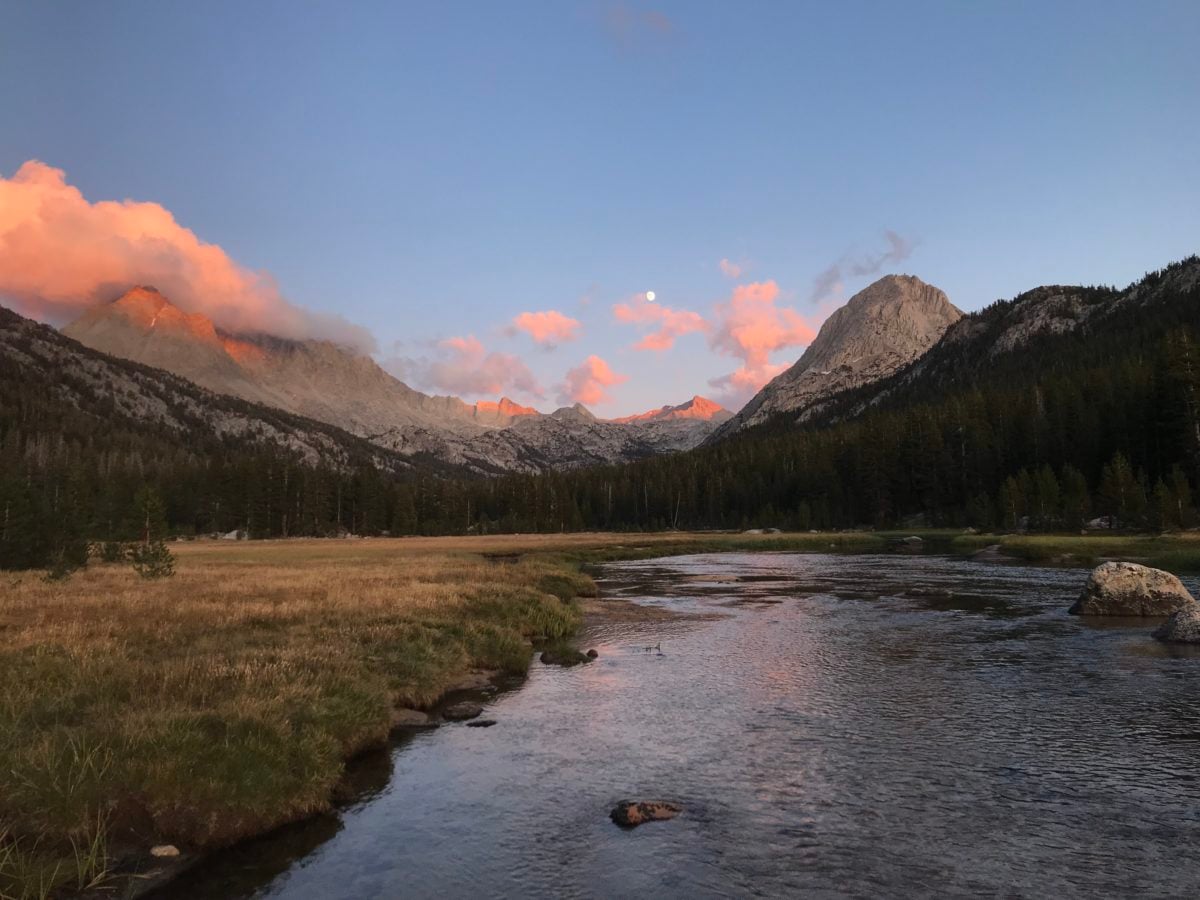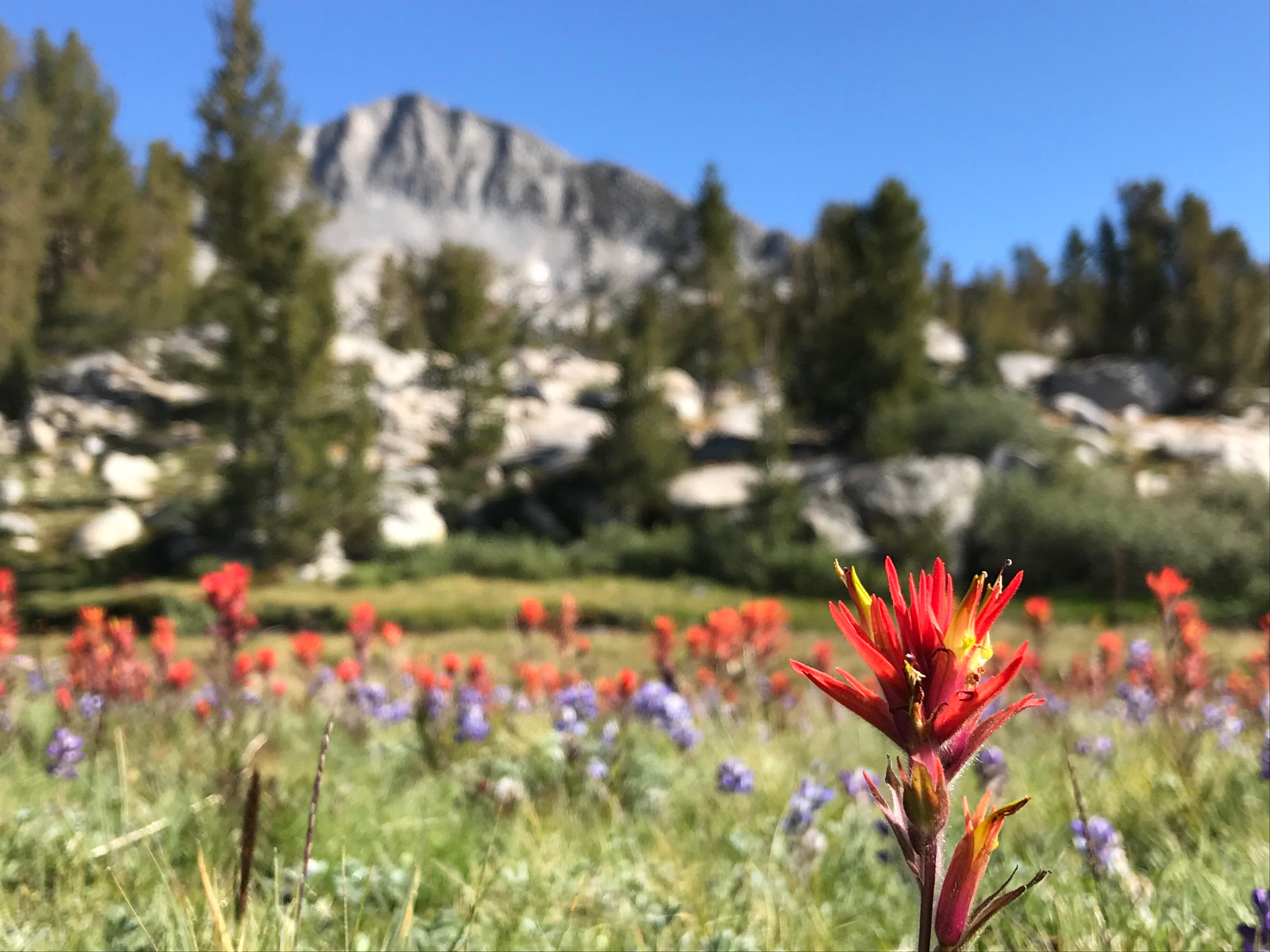I can still remember the moment we started; Tuolumne speeding by outside the window, the dense pines lining the meadows, pulling into the long-term parking lot and hoisting our 55-pound packs on our backs. The first streaks of blood-orange light filtered in above the horizon as we began our journey on the John Muir Trail, or JMT.
Those first steps were tentative. I hardly knew Andrea and Katriona, the two classmates I was backpacking with. And the trail was several times longer than anything I had attempted before, 19 days woven between alpine lakes and towering granite, sequoia forests and sprawling vistas. The JMT is 211 miles of High Sierra spanning from Yosemite Valley to Mount Whitney, the No. 1 exposition to the Range of Light.

The first steps were the best type of pain. High elevation, steep uphill climbs and backpacks weighed us down, but they could do nothing against the excitement I felt to finally be on the trail. After two weeks of planning and packing it was a relief and a shock to finally begin. Going from rushing around San Francisco buying powdered hummus to suddenly being out there, surrounded by beauty and stillness and planning nothing except where to set up camp, well that was more than a shock. It takes 48 hours before you notice the birds chirping around you.
As we meandered south we learned more about each other and the mountains. The Sierra Nevada seemed to outdo itself every day. Garnet Lake, Rainbow Falls, McClaren Meadows, Evolution Valley; we kept a tally of how many times one of our group stopped and said “wow” until we reached triple digits. Of course, there were some close calls, and not everything was perfect. In the timeless “Essays in Idleness”, medieval Buddhist monk Kenkō asks, “Are we to look at cherry blossoms only in full bloom, at the moon only when it is cloudless?” Similarly, our discomforts were part of our John Muir Trail just as much as the views. Our tent flooded in the middle of the night on day four, both of my trekking poles broke, twice, as well as both of my boots, and we didn’t pack enough food, leaving us cold and hungry for several nights. We packed up camp at dawn with cracked fingers, pausing just long enough to pump ice water into our instant oatmeal before continuing on.
Early on in our trip, maybe Day 3, we hiked to a beautiful lake called Thousand Island Lake, a large alpine lake dotted with brushy islands in front of dark snow-spotted mountains. I decided to swim out, and after reaching an island in the middle of the lake I laid out on a rock to sunbathe and nap. Seconds later, a massive thunderclap shook the air and a huge storm peaked out from behind the mountain before approaching the lake at a terrifying speed. As the sunlight rapidly diminished, it dawned on me how dangerous it was to be trapped on a car-sized island in a huge thunderstorm. I don’t think I’ve ever swam so fast in my life.
The JMT forces you to surrender to its pace, but it also teaches you about itself on the way. When I saw a Sequoia tree in Kings Canyon National Park, posing magnificently by the trail, I knew we were further south by its bark and branch structure. I learned where trout swim in the morning versus at night, and which birds lived at which elevations. I could see the time passing as the moon changed phase overhead and embrace it as each morning’s cold bit harder and each evening’s end started sooner. After being on campus for so long I forgot it was even possible to go to sleep when the sun sets.

This deference to nature seemed to have soaked into everyone else we met; sometimes it felt divine. We encountered many sparkling eyes on the trail, but one moment stood out as something special. It was the morning of day 16 and we had just reached the top of Glen Pass, when three successive groups arrived to join us. Mind you, we normally saw just a few people per day. The first group was a young couple that was hiking the entire trail in nine days so they’d be back in time for their daughter’s first birthday. Following them were two guys hiking the Pacific Crest Trail (a trail that overlaps with much of the JMT but spans from Mexico to Canada) who had met on the trail and had clearly reached nirvana. They seemed to float an inch above the ground, and as they told us wild tales of their travels the timbre of their voices seemed to fill with an all-encompassing love. I had to glance at Katriona and Andrea to make sure I wasn’t hallucinating the pair of modern-day saints in front of us. A little time after that, a young guy came up playing Wild Horses on a guitar, gave us two dinners worth of food and took all of our trash. He was doing a three-day loop that overlapped with ours. He must have seen the hunger on our faces. Had we ascended the pass 20 minutes later, let alone a day, we would have never met these people. After the solitude of the past few days, the appearance of five incredible people at once was too much to take in, and we sat on top of that pass for another hour, feeling as full as can be.
As we reached the final days of our trip our fitness improved and the discomforts began to lessen (although the hunger never abated). The scenery was staggering and we ascended over mountain passes nearly every day, each one rewarding our dogged climb with a sprawling view of the next valley.
With time to think, my mind wandered to “On Trails” by Robert Moor, a book I picked up freshman year. While thru-hiking the Appalachian Trail and developing its extension into Canada he investigates the concept of a trail, how trails are stories, narratives set in a physical landscape created by animals to pass on to others, and how each person that walks a trail adds to the story, mixing with it and creating something unique.
The trail ends on the summit of Mount Whitney. In all directions we could see granite peaks scratching the sky. From above, the part of the JMT we had just completed stretched out into the distance, the details of each step already blurring into one giant memory. I looked at Andrea and Katriona. It seemed impossible that we had departed as nearly strangers just 19 days ago. The presence of the mountains reeled us in — that vast expanse of rock and life unfolding across California. In its own way it was the greatest literature in the world. We overcame its challenges together, and wrote that shared experience into its story for the next thru-hiker to read. On Day 15 I wrote in my notebook, “more so than any of the many individually spectacular views, it’s the cumulative experience on the JMT that makes conveying it here impossible.” It is still just as true. Luckily, the Sierras lie just to the east of Stanford, any and all of it waiting for you.

Contact Tai Kao-Sowa at tkaosowa ‘at’ stanford.edu.
